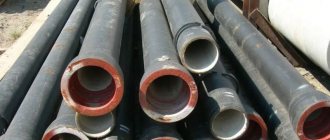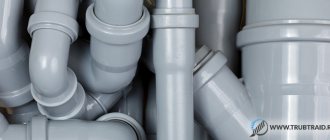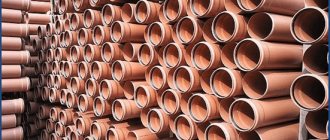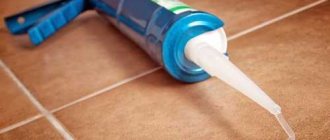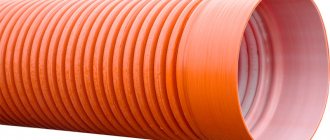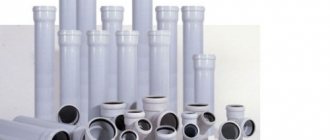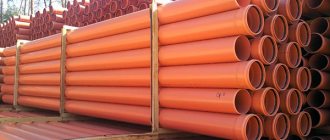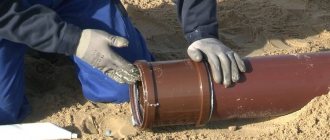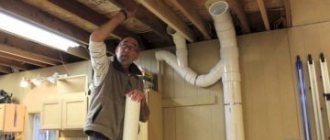Let's look at cast iron pipes for sewerage: dimensions, diameter and classification. As well as technical characteristics, advantages and disadvantages of these pipes in the apartment. First things first.
Modern sewer systems are usually assembled from PVC or propylene pipes. However, the widespread transition to plastic has not been able to completely eliminate cast iron sewer pipes from use, the dimensions of which are somewhat different from more modern varieties. The performance qualities of traditional varieties are noticeably ahead of new models, therefore, despite some disadvantages, they are still actively used for assembling critical sewer lines. Let's take a closer look at them.
Pre-installation preparation of cast iron pipes
As mentioned above, due to the large weight of cast iron products, their delivery to the job site and assembly are significantly difficult.
Therefore, and also for the purpose of safe and long-term operation of the equipped pipeline, before starting work with the products, it is necessary to check them for all kinds of defects. In addition, the material is highly fragile, so even dropping the product from a small height can damage it irreparably.
To eliminate such factors, before starting work you need to:
- inspect the ends and sockets of the products, noting the presence or absence of irregularities;
- check that there are no significant variations in diameter along the length of the pipe;
- evaluate how good the bitumen coating is - it should be smooth, uniform, and not become sticky even at elevated temperatures;
- tap the products along the entire length, making sure that the sound is uniform and thick;
- make sure that all auxiliary materials (cement, tow, etc.) are prepared before starting work.
Positive and negative qualities
Today, cast iron pipes are installed in most sewer systems. The properties of these products allow them to be installed in any type of soil. The main advantages are:
- very high strength;
- not afraid of temperature changes;
- long service life;
- does not burn;
- meets modern environmental requirements, does not emit toxic substances;
- has excellent soundproofing properties;
- does not react with aggressive substances;
- not afraid of corrosion.
Unfortunately, in addition to such a large number of positive properties, cast iron products also have a number of characteristic disadvantages. Some factors greatly influence the labor intensity when installing a sewer system:
- large mass;
- increased fragility;
- installation requires special equipment and additional materials;
- very high cost;
- repair work requires large financial investments.
Features of cast iron pipes
New plastic drainage system pipelines. They are cheaper, light weight and easier to assemble. All alternative options are used only in systems that operate in difficult conditions.
If the pipeline is cast iron, the sewer joints will have to be processed separately. Each connection requires caulking (this is what experts call the compaction procedure during assembly). This applies to socket parts equipped with special connecting elements. There are also products that are assembled using couplings. They are not equipped with connecting units, which simplifies production, but additional parts are required for installation. They are expensive, which increases costs and the overall cost of the network. The coupling method is used to install pressure-type cast iron sewers. It is widely used in industrial wastewater systems.
The system includes two groups of parts:
- pipes. These are straight elements that form straight extended sections of the network;
- fitting. These are parts designed for branching or turning channels. In addition, fittings are used for cleaning and other types of system maintenance.
Since the rules for laying networks were developed a long time ago, on metal pipelines, the basic requirements for installation work differ little from modern standards. Required to provide:
- line slope, which depends on the diameter of the pipes;
- tightness, no leaks;
- When laying, the sockets should be directed towards the starting (highest) point of the line.
Installation of sewerage from cast iron pipes is carried out at the stage of primary construction of buildings or structures. Later assembly of systems requires destruction of the finishing of the premises. Before assembly, it is necessary to calculate the network, draw up a diagram and a working drawing of the line. This is an important stage in the construction of the system, since working with metal elements is complex and requires effort and time.
Advantages and disadvantages
The advantages of cast iron drainage networks include:
- strength;
- ability to withstand high pressure and large external loads;
- low coefficient of thermal expansion;
- long service life;
- cast iron pipes are less susceptible to corrosion;
- low noise level.
Flaws:
heavy weight When working with large diameter pipes, lifting equipment is required; connecting cast iron sewer pipes is complex and time consuming; cast iron is fragile
Assembly must be done carefully so as not to split the connecting elements; the surface of the material is rough, which promotes the growth of fatty deposits on the walls; the finished line is difficult to repair or replace individual elements.
The disadvantages of metal elements led to a transition to more convenient plastic lines. However, systems operating in difficult conditions and withstanding significant loads are still assembled from cast iron parts. If the assembly is done with high quality, the line can operate for up to 100 years or more, which makes the material relevant in the present day.
Sewer repair
During operation, cast iron pipes may be damaged. Cracks, chips or other defects form on their surface. In this case, repair of the sewer network is required. It is carried out as follows. A rubber gasket is applied to the damage. For the best effect, use 2-3 pieces. The gaskets are pressed with metal hoops.
Repairing a small leak in a pipe is done differently. Initially, it is slightly expanded and degreased. Next, a repair composition is prepared, consisting of copper oxide and phosphoric acid in a ratio of 1.5:1. The crack must be sealed immediately, as the solution hardens very quickly.
Thus, cast iron pipes are a very effective option for sewerage installations. They have excellent performance properties, their service life can exceed 100 years. In case of damage, they are quickly repaired. However, it is worth remembering their fragility and low resistance to impact loads. The heavy weight complicates the installation process.
Cast Iron Pipe Standards
The weight, diameter and other dimensions of cast iron sewer pipes, as well as other requirements are specified in the GOST standards “Cast iron sewer pipes and fittings for them” - 6942-98 and 9583-75.
The first article prescribes the requirements for pipes for domestic use - 50, 100 and 150 mm in diameter, and the second the requirements for pressure products with a diameter of up to 2000 mm.
Household products:
- are produced with bells; socketless products can be manufactured only by agreement with the customer;
- GOST regulates all diameters: internal, external, socket diameter;
- length, according to the rules, can be equal to 750, 1000, 1250, 2000, 2100 and 2200 millimeters;
- the diameter cannot fluctuate by more than 0.2 mm, and the length by more than 0.9%;
- the presence of any external defects is not allowed;
- the edges of any of the ends can be smoothed or rounded;
- cast iron pipes are supplied to the consumer only after applying an anti-corrosion coating to the internal and external surfaces;
- in production, diameters of 50, 100 and 150 mm are observed.
Pressure pipes
Features according to GOST:
- the measured length of pipes can range from 2 to 10 meters in increments of one meter;
- according to GOST standards, pressure products undergo mandatory hydraulic testing under a pressure of 20 kgf/cm2;
- the anti-corrosion coating of such pipes must be approved by the Ministry of Health;
- The diameter of the products can be from 65 to 2000 mm.
Installation of cast iron pipes
The general rules for installing sewerage on the street (usually pipes with a diameter of 100-150 mm are used) and in the house (a 50 mm pipe is suitable for wiring), repair and dismantling are the same for all pipes.
It is necessary to pay attention to the depth of soil freezing, maintain slopes, avoid a large number of bends and turns, and, if necessary, insulate. Tapping into cast iron is done using a grinder
Let's move straight to the features of installing cast iron products.
Joining using a socket:
the tail part of the pipe is inserted into the bell (extension) of the previous link; the resulting gap must be sealed with special tow, using a wooden or rubber hammer for compaction; the remaining space is filled with solution or sulfur; Considering the weight of the product, it is better to place stands under the pipeline until the joints completely harden; to organize turns or branches, angles and tees made of the same brand of cast iron are used; inserting a cast iron pipe into a wall or foundation should be done with the utmost care, taking into account the fragility of the metal;
Socketless connection:
Under the influence of progress, cast iron products have a new modification, from which socketless cast iron sewerage is installed. Pipes of all diameters (50, 100, 150 mm) are securely connected using stainless steel clamps.
- the pipeline is installed end-to-end using clamps that attract a rubber cuff that is resistant to aggressive environments;
- the cuff is tightened with bolts;
- to transport wastewater under pressure, the joint must additionally be sealed with a special crimp collar;
- Considering the weight of cast iron, sagging of the pipeline is not allowed.
It is worth noting that you are unlikely to need repairs and dismantling of cast iron sewers, because cast iron lasts a very long time. But, if you still need to carry out such manipulations, follow the following rules:
- Repair and dismantling is carried out using only rubber or wooden tools so as not to split the pipe.
- Repair of cast iron products is carried out using the same materials as their joining: mortar, sulfur, cuffs, clamps.
trubypro.ru
External sewerage
The external sewer system runs underground on the street and carries wastewater to the septic tank. Pipes for external sewerage can withstand static and dynamic loads:
- soil pressure,
- movement of people
- traffic,
- groundwater movement,
- temperature changes,
- humid environment,
- aggressive environments.
Dynamic loads. These are all variable loads: movement of cars and people, movement of groundwater. Pipes with high ring stiffness can withstand dynamic loads well.
Static loads. These are loads that constantly put pressure on the pipeline: soil pressure. Products with high ring rigidity also resist pressure well. Static loads also include others; we will consider them separately.
Temperature changes. The most dangerous are cold snaps, since many pipes can withstand 30-degree heat, but cannot cope with 30-degree frost.
Wet environments. High humidity in spring and autumn destroys ferrous metals without anti-corrosion coating and some other materials. Groundwater movement can dislodge the pipeline if it is not installed correctly.
Aggressive environments. These are acids, salts and alkalis that are found in soil and wastewater. Therefore, pipes inside and outside must be resistant to various substances.
Range of cast iron pipe products
There are only three units of the range, which differ in cross-sectional size. There are two main types: SMU - with smooth ends and SME - one end is smooth, the other with a socket. Pipe products made of cast iron are marked according to their nominal cross-section.
The first part of the inscription is the grade of material, the second part is the nominal cross-section (for example, if the marking indicates DN 100, then the internal diameter of the cast iron sewer pipe is 100 mm, the outer diameter is Ø110 mm). Products with a socket are divided into 3 classes - A, B, LA (depending on the wall thickness).
| Table of sewer pipe diameters | ||||
| Outer dia. (mm) | Nominal diameter (mm) | Wall thickness | ||
| Class A | Class B | Aircraft class | ||
| 81 | 65 | 7.4 | 8.0 | 6.7 |
| 98 | 80 | 7.9 | 8.6 | 7.2 |
| 118 | 100 | 8.3 | 9.0 | 7.5 |
| 144 | 125 | 8.7 | 9.5 | 7.9 |
| 170 | 150 | 9.2 | 10.0 | 8.3 |
| 222 | 200 | 10.1 | 11.0 | 9.2 |
| 274 | 250 | 11.0 | 12.0 | 10.0 |
| 326 | 300 | 11.9 | 13.0 | 10.8 |
| 378 | 350 | 12.8 | 14.0 | 11.7 |
| 429 | 400 | 13.8 | 15.0 | 12.5 |
Characteristics of crosses
When installing communication systems, the main thing is not to forget to take into account the pipe branching factor. Using a cross for these purposes allows you to save space and make the best use of the material. Branching occurs in two planes. Document 6942 has the characteristics of crosses. The angle between the key and secondary axis is 87° 30? with a possible deviation of 1° 30?.
You need to pay attention! The mass of straight crosses with an offset axis of removal is 7.6 kg. The axis shifts by 25 mm.
Characteristics of oblique crosses at 60° with a possible deviation of 1° 30? are given in the table. Linear dimensions are given in centimeters.
Table 13
Symbolic passage: key/bends 10/5.0
15/5Distance from the branching point to the expansion89.2Distance from the branching point to the shank9.58Distance from the branching point to the branch expansion912.0Weight without anti-corrosion coating, kg5.87.05/510/1015/109.01518.010118.59.01518.84.010.510 ,5Two-plane crosses according to GOST 6942 are available in left and right versions.
Standard sizes of sewer pipes and their purpose
Modern industry produces sewerage pipes in accordance with the required technical standards. Indicators vary for each type of room (kitchen, bathroom, toilet), and also depend on the expected load on the system. The last point is determined by the number of family members living in the apartment or house.
The main parameters that it is recommended to pay attention to when choosing sewer materials are the following:
- internal diameter - the main parameter, which is fundamental for the entire sewer network, is designated as “D”;
- nominal diameter – designated “DN”, determines the nominal value of the internal diameter of the pipe;
- nominal diameter - designated “DN”, indicates the total diameter of the entire structure.
In addition, professionals pay attention to the thickness of the pipe wall and its material of manufacture. In addition to technical data, it is worth paying attention to the components - when choosing adapters, you must adhere to exact compliance with the dimensions and purpose of the products
PVC
The tables show values for internal and external plastic sewage systems.
Table No. 1 - internal system:
| DN (mm) | D (mm) | Wall thickness (mm) (minimum value) | Wall thickness (mm) (maximum value) |
| 32 | 30 | 1 | 1.8 |
| 40 | 38 | 1 | 1.8 |
| 50 | 47.4 | 1.3 | 1.8 |
| 75 | 71.2 | 1.9 | 2.3 |
| 90 | 85.6 | 2.2 | 2.8 |
| 110 | 104.6 | 2.7 | 3.4 |
Table No. 2 – external system:
| DN (mm) | D (mm) | Wall thickness (mm) (minimum value) | Wall thickness (mm) (maximum value) |
| 125 | 118.6 | 3.2 | 3.9 |
| 160 | 153.6 | 3.2 | 4.9 |
| 200 | 192.2 | 3.9 | 6.2 |
| 250 | 240.2 | 4.9 | 7.7 |
| 315 | 302.6 | 6.2 | 9.7 |
| 400 | 384.6 | 7.7 | 12.3 |
| 500 | 480.4 | 9.8 | 15.3 |
| 630 | 605.4 | 12.3 | 19.3 |
| 800 | 769.2 | 15.4 | 24.5 |
| 1000 | 960.8 | 19.6 | 30.6 |
| 1200 | 1151 | 24.5 | 36.6 |
The optimal pipe sizes for internal sewerage are considered to be 32-110 mm. For outdoor – 160-500.
Based on the fact that manufacturers produce almost all possible sizes of sewer components, choosing the optimal one for individual housing is not a problem. The most common values, which also comply with the approved SNiP requirements, are considered (data in mm):
- washing machine and dishwasher – 25;
- sink – 30-45;
- bath, kitchen sink – 40-50;
- combined drain (bathroom, bathtub) – 50;
- riser outlet – 70-85;
- central drain - 110-120.
The indicators are typical for internal sewerage. When laying sewerage outside the house, it is recommended to use plastic components of the following diameter (data in mm):
- output to the cleaning system – 160-200;
- removal of water from the bath – 200;
- swimming pool – 230;
- city sewer network - from 300 to 1100.
Summarize
No person can live without sewerage. Her choice must be made very wisely. Cheap plastic is not suitable for residential premises or other administrative institutions. It quickly breaks down and requires constant maintenance and repair. Installed cast iron sewerage never creates noise. Its installation does not require work on the manufacture of additional sound insulation.
Cast iron is capable of functioning under high pressure and is designed for a long service life. The heat resistance of the material and its strength will be in demand in subsequent years.
How to determine pipe sizes
Foreign-made polypropylene, polyvinyl chloride and other plastic communications are most often designated by inches. It may also be that you need to install fasteners on the pipeline, but its dimensions are also given in inches, while the pipe is indicated in mm.
Pipe inch thread
To do this, you need to convert the known inch dimensions into millimeter ones. According to the data, 1 inch is 25.4 mm. It turns out that a pipe with a diameter of 2 inches = 50.8 mm, etc. Fractional values are very often used, this is how clamps, fittings, couplings and communications are marked.
Let's look at their meaning in the table:
| In inches | In millimeters | In inches | In millimeters |
| 1/8 | 3,2 | 1 1/8 | 28,6 |
| 1/4 | 6,4 | 1 1/4 | 31,8 |
| 3/8 | 9,5 | 1 3/8 | 34,9 |
| 1/2 | 12,7 | 1 1/2 | 38,1 |
| 5/8 | 15,9 | 1 5/8 | 41,3 |
| 3/4 | 19 | 1 3/4 | 44,4 |
| 7/8 | 22,2 | 1 7/8 | 47,6 |
| 2 1/8 | 54 | 3 1/8 | 79,4 |
| 2 1/4 | 57,2 | 3 1/4 | 82,6 |
| 2 3/8 | 60,3 | 3 3/8 | 85,7 |
| 2 1/2 | 63,5 | 3 1/2 | 88,9 |
| 2 5/8 | 66,7 | 3 5/8 | 92,1 |
| 2 3/4 | 69,8 | 3 3/4 | 95,2 |
| 2 7/8 | 73 | 3 7/8 | 98,4 |
PVC pipes of different diameters
But, when measuring a socket manually, for example, with a ruler, the nearest minimum size is always taken. For example, the diameter in millimeters of a sewer pipe for a sink is 34. It turns out that the outer diameter is 1 ¼ inches. Be careful when selecting sizes, otherwise you will have to buy additional spacers or adapters. But the coupling is selected based on the nearest larger indicator, i.e., 34 mm will be considered 1 3/8 inches.
Video: Joining pipes of different diameters in the sewer system.
Steel two-way communications may have different indicators on different sides; you need to double-check the data. This can be done by experimental measurements with a caliper or plug gauge.
Table: Diameters of ceramic pipes
Published by admin
View all posts by admin
Add a comment Cancel reply
You must be logged in to post a comment.
The advantage of an acrylic bathtub
09/08/2020 No comments on the post The advantage of an acrylic bathtub
DIY box for storing vegetables on the balcony in winter
08/28/2020 There are no comments on the post Do-it-yourself box for storing vegetables on the balcony in winter
Do-it-yourself potato storage box on the balcony in winter
08/28/2020 There are no comments on the post Do-it-yourself box for storing potatoes on the balcony in winter
Do-it-yourself Japanese furako bath
08/28/2020 There are no comments on the post Japanese furaco bath with your own hands
Welsey apple tree, description, photo, reviews, planting
08/28/2020 There are no comments on the entry Welsey apple tree, description, photos, reviews, planting
Apple tree lungwort, description, photo, reviews, planting
08.28.2020 No comments to the post Lungwort apple tree, description, photos, reviews, planting
How to choose?
To select the required diameter of sewer system pipes in an apartment or private house, you should calculate all expected drains. Most often, the main pipe leading to the riser is installed with a diameter of 110 mm in order to easily drain both plain water and sewage. And the sizes of the remaining drainage channels depend on the type of plumbing to which they are connected.
Sink
The shaped parts of any washbasin, as a rule, are designed to combine them with pipes with a diameter of 40 to 50 mm. It makes no sense to install larger elements, as this will entail unnecessary expenses and clutter up the free space.
Toilet
The largest pipe used to drain sewage and water from plumbing elements is a pipe with a diameter of 100 mm connected to the toilet. With such a width of the product, its length should be minimal, and its location in space should not allow bends and turns. The earthenware or ceramic product itself is connected to the outlet using a corrugated element, the lower end of which is inserted into the pipe. The corrugation should also not be twisted or have a large length.
Bath
Although the volume of water leaving a filled bathtub is several times greater than the same volume of a toilet bowl, it is enough to use a drain pipe with a diameter of 50 mm. This is due to the fact that a small drain hole at the bottom of the bath will not allow a larger flow to exit from it. In addition, a small grille is additionally installed at the hole itself, which reduces the rate of water loss several times.
The shower cabin can be connected to a pipe of even smaller diameter, since such a large volume of water does not drain from it at one time. The diameters of the pipes for it can vary from 32 to 50 mm. Most often, a 50 mm pipe is installed, since it is more universal and you can connect the drain to it from both the sink and the washing machine.
Washing machine
The diameter of the drain hoses of almost all models of washing machines is 32 mm, which means the minimum size of the outlet pipe. However, installing a separate outlet pipe to connect a washing machine is a rare case. Therefore, the hose is connected through a special rubber collar to a conventional 50 mm pipe of the internal drainage system.
Kitchen
In the kitchen, both one sink and a washing machine and dishwasher can be connected to one pipe. The diameters of their bends differ significantly from each other, so it makes sense to lay one pipe with a 50 mm diameter, and connect all smaller bends to it with special cuffs or other fittings.
Product inspection mechanisms
The designation of the amount of non-straightness of a cast iron sewer pipe (GOST 6942-98) is carried out using a height gauge that meets GOST 164, a control horizontal plate and two steel prismatic supports of the same height.
Prismatic supports are placed parallel to one another on the control horizontal slab. The distance between them must be more than half the length of the product to be checked. The pipe is placed on the supports with the deflection downwards. Using a height gauge, the distance from the plane of the slab to the bottom point of the cast iron pipe is measured with an accuracy of one tenth of a millimeter in the place where the deflection is greatest.
The deviation from the straightness of the product per 1 meter of its length (?) is calculated by the formula:
In the expression, b is the height of the support in millimeters; c is the distance from the plane of the slab to the bottom of the pipe in millimeters; d – distance between supports (in m).
The softening temperature of the anti-corrosion layer is checked according to GOST 11506. Its adhesion strength to the pipe metal is examined by making mesh-shaped cuts on the coating using a knife blade. The distance between grid lines is at least 40 mm.
You need to pay attention! If the coating is applied with high quality, there will be no peeling when making cuts.
Testing the stickiness of the anti-corrosion layer is created at a temperature of 15-30 ° C by pressing a clean paper sheet (writing sheet) to the pipe coating in accordance with GOST 18510. The layer is considered non-stick if no traces of the coating remain on the paper carrier after its removal. Such a check is carried out as recently as a day after applying the anti-corrosion layer to the product.
The outer colored coating of pipes is protection against corrosion processes; the layer of this protection is also examined for absence of damage
Metal-plastic
Metal-plastic pipes do not have many of the disadvantages that are typical for products made of pure metal or plastic. The structure of such a pipe is quite simple: the aluminum layer is covered from the inside and on top with layers of polymer origin.
The service life of metal-plastic collectors is significantly affected by:
- ultraviolet radiation;
- working pressure value;
- installation method;
- temperature constancy. This means that you cannot first run hot water through the same pipe and then immediately run cold water. Such a procedure, if it becomes regular, can lead to delamination of the pipe, since aluminum and plastic have different thermal expansion coefficients.
If you adhere to these conditions, then metal-plastic collectors can last up to 40-50 years.
Tags
eggplant disease spring video grow growing soil dacha doors tree home home honeysuckle winter instructions cabbage potatoes brick strawberries kitchen furniture carrots pruning cucumber description open ground pepper preparation tomato planting sowing seedlings plant recipe plant currant seed with your own hands variety greenhouse tomato pipe care photo flower
Welded, seamless, rectangular pipes - characteristics and applications
08/23/2020 No comments on Welded, seamless, rectangular pipes - characteristics and application
Paving slabs: advantages and production
05/14/2019 No comments on the entry Paving slabs: advantages and production
Features of choosing the diameter of waste pipes
The question of what diameter of sewer pipes should be selected is one of the first when designing. Typically, pipes with a diameter of more than 100 millimeters are suitable for toilet drains, and up to 50 mm in the kitchen and bathroom.
The diameters of sewer pipes have a wide range of values due to two factors:
- The toilet is a plumbing fixture, the features of which include the passage of a very large volume of water in a short period of time at the time of flushing. It may contain solid fractions, with which a pipe with a smaller diameter is more likely to clog.
- Despite the fact that when the bath is emptied a lot of water is also drained, the drainage pipes are made of a much smaller diameter. This is due to the fact that, according to hydraulic conditions, the permeability of the pipe is equal to the permeability provided by its narrowest point. And in the bathroom the outlet has a disproportionately smaller diameter, in addition, it is blocked by a grill. This makes it impractical to install a large diameter pipe in relation to the bathtub.
Pipe diameter for series-connected plumbing fixtures
What to do if in the toilet room there is a bidet in addition to the toilet? In this case, the diameter of the sewer pipe should not be increased to 150 or 200 mm. This is explained by the following formula: the permeability of a pipe depends on the square of its diameter.
That is, if we take a two-hundred-millimeter pipe, we find that its permeability is four times greater than a pipe with a diameter of one hundred millimeters. In addition, it is almost impossible for the toilet and bidet tank to be filled to the maximum.
Diagram of the correct selection of pipe diameters in the direction of movement of the drains to the riser
In other words, the diameters of sewer pipes - toilet pipes are taken larger not because a smaller diameter will not allow the required volume of water to pass through.
It should be noted that in order to pass the required volume of wastewater, including solid fractions, the pipe must have an air gap
This is important because when the water front moves through the drain pipe, air is displaced and is under high pressure
The vacuum formed in the absence of an air gap in the pipe can squeeze out the water seals in all outlets, thereby causing a lot of troubles, from the appearance of an unpleasant odor in the room to the need to wash plumbing fixtures.
https://youtube.com/watch?v=x7LSxcXYiMw
https://youtube.com/watch?v=rBSOMS8P62o
Carrying out leak testing of products
To test the tightness of shaped components and pipes according to document 6942-98, you need a stand, a pump and plugs (with a pipe section and blind ones). The stand is equipped with a device for determining the pressure value, the division value of which is no rougher than 10 kPa. The pump must create a hydraulic pressure of 0.2 MPa.
Shaped parts and pipes for sewerage are on the stand. A plug with a piece of pipe is placed on the hole closest to the pump, which provides a connection to it. A plug with a piece of pipe is placed on another hole for the purpose of draining water. If there are other holes, blind plugs are placed on them.
Using a pump, the area being tested is filled with water, a valve or other shut-off mechanism closes the section of pipe for water drainage, and a pressure of at least 100 kPa is created in it. Maintaining this pressure lasts for at least 15 seconds. During this time, the connections of the pipeline section are inspected.
If there is no water leakage through the socket joints and walls of the pipeline, or fogging of the outer surfaces of the shaped components and pipes, then the area being examined is considered impermeable.
Metal sewer pipes - how to connect cast iron and steel
Metal sewer pipes can be connected in only two ways:
- Installation in socket
- Welding installation.
Moreover, welded installation is practiced only in the process of assembling a sewer system from steel pipes. But socket installation is typical only for cast iron pipes. Next we will look at both processes.
Connection of cast iron communications (into a socket)
Before connecting sewer pipes - cast iron to plastic or cast iron to cast iron - you need to take into account that the assembly process looks identical to the operation that is practiced when installing plastic pipelines. That is, to install cast iron pipelines you just need to insert the smooth end into the socket of the previous pipe. Differences in the assembly process of cast iron and plastic pipes will only be noticeable during the process of sealing the joint
The process of pressing the rope—chasing the joint—is performed as follows:
- The pipe is centered in the socket using wooden or metal gauges driven into the slot.
- After centering the pipe, the first turn of tarred rope is wrapped around it, which is driven into the joint at ¾ of the depth of the socket.
- Next, a second turn is wrapped around the pipe, which is minted after the first. And so on.
- At the very end of the embossing, we apply a cement patch to the seam (on top of the rope).
The result is a very strong and tight connection.
Welded connection of steel communications
This installation method does not involve the use of fittings (couplings or tees). Communications are connected by a weld seam applied to the joint of the mounted elements. To implement this process, either gas (oxyacetylene) or arc (electric) welding is used. Large-diameter pipes are joined using a special welding machine. Well, small-sized pipelines with a diameter of 50-150 millimeters are welded manually.
This installation method is the most reliable and cost-effective: the homeowner only pays for the pipes. However, to implement it you need
Assembly method
In practice, you often encounter two types of connections:
- pipes of the same type, that is, cast iron;
- assembly plastic-cast iron.
Let's look at each of them in detail.
How the connection is made.
The use of socket pipes makes installation more convenient, so let’s look at how they are joined.
The algorithm of actions is performed in the following order:
- The ends of the pipes to be connected are cleaned, after which lubricant is applied to the socket and the smooth end, and then they are joined. It should be noted that the socket must be on the pipe to which the connection is made. That is, to an already installed one;
- Next, chasing is carried out; for this, a tarred sealant (for example, tow) is inserted into the gap between the socket with the flat end of cast iron sewer pipes. They need to fill the bell about two-thirds full. The tool used is a wooden spatula and a hammer;
- to fill the remaining space in the socket, a non-impregnated sealant is used, this improves the quality of adhesion to cement;
- Cement mortar is prepared, we recommend using grades 300 or 400 in a proportion of 1/9 to water;
- the prepared solution is poured into the socket, after which it is compacted.
Implementation of a socket connection
When joining, it is very important that the connection is completely sealed. For this purpose, when installing sewer pipes made of cast iron, the cement solution is replaced with a sealant
This option is more reliable, but much more expensive.
How to connect a cast iron sewer pipe to a plastic one.
This type of docking is much simpler. To connect cast iron and plastic pipes of the sewer system, you will need to buy a connecting collar and sealant.
Connecting cuff
The process occurs in the following order:
- it is necessary to clean the inner surface of the bell;
- sealant is applied to the cleaned area;
- The cuff is installed, a plastic pipe is connected to it, after which the connection takes the form shown in the figure.
Connecting a plastic outlet to a cast iron riser
